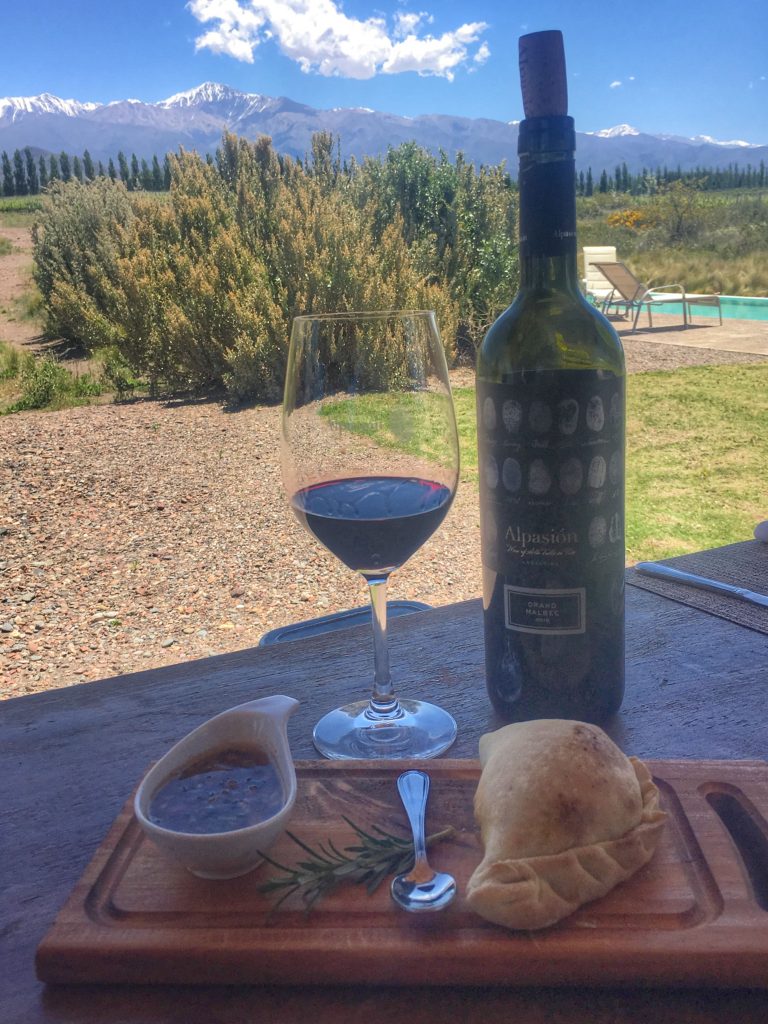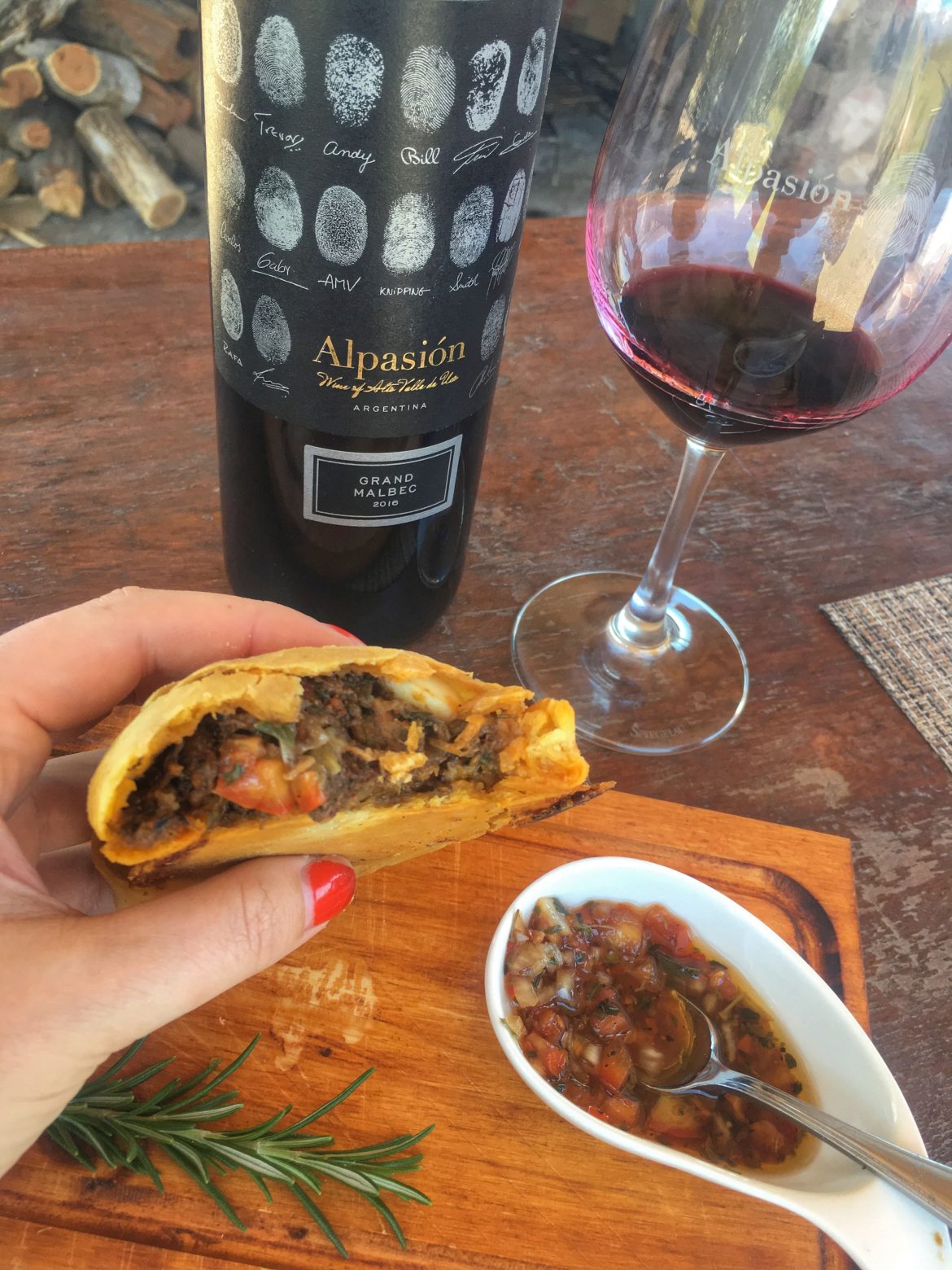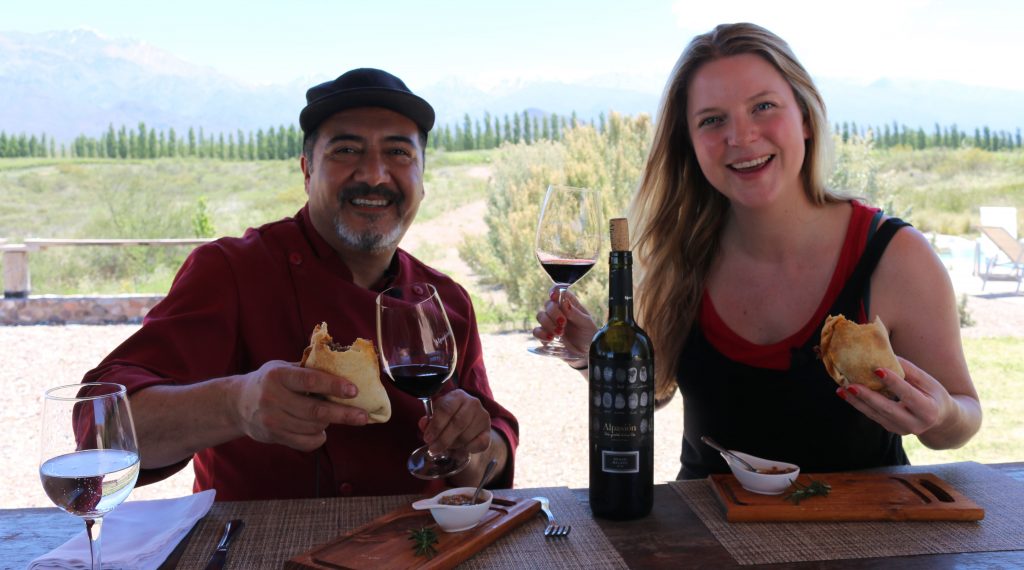The ultimate empanada recipe is different for every chef in South America – every region has its own twist on the infamous pocket of stuffed pastry. We share our ultimate recipe for empanadas from Mendoza, but there are many regional variations that are worth exploring too!
In Chile, the empanadas come large, fried and are often stuffed with seafood. Along the coast, you’ll find empanadas de jaiba (crab), empanadas de camaron (shrimp), empanadas de ostiones (scallop), and empanadas de mariscos (mixed seafood). These often come stuffed with soft, buttery cheese as well. While, further inland in Chile, you’ll more likely find the ubiquitous empanadas de pino (meat empanadas), which are usually square pockets filled with minced beef, and sometimes egg, black olive, spices and herbs.
An Argentine empanada is generally small, baked and filled with beef (and gets spicier in the north!) Empanadas Salteñas, from Salta, usually include lots of aji pepper and cooked potato with their beef; while in Mendoza it is the inclusion of onion that makes it notably different. Perhaps the most famously different beef empanadas are the empanadas of Cordoba which are slightly sweet – stuffed with not only beef but also raisins, carrot and a dusting of sugar. In Catamarca, goat empanadas are more common, made of chivo or cabrito, and Patagonian empanadas are often of lamb or seafood. In Buenos Aires, you get a big mix of empanadas with humita (corn), jamon y queso (ham and cheese) and chicken empandas very popular, alongside the classic beef empanadas.
Uruguayan empanadas come both fried and baked and can either be quite similar to the Argentine empanada, or (further east in the country) they are closer to the Brazilian empanada (or pastel or pastéis). Brazilian pastéis are commonly made of cheese; chicken; or beef. But my favourite is the rarer Pastel de Carne de Sol made with dried meat.
There’s a whole world of empanadas to discover, but last week I visited Alpasión in Mendoza’s Uco Valley to get Chilean-born, Argentine-bred chef Héctor Ordenes’ take on the perfect empanada recipe and a guide on how to make empanadas. Recipe below!
How to make empanadas
Empanadas take preparation and the act of making, or folding, your empanada is the last and easiest part. Before you get started on making empanadas you need to prep your dough and your filling.
You want to start prepping your filling before your dough because you need the meat to be room temperature or even chilled before you use it. Héctor also says you can prepare the filling and the dough earlier in the morning, or the night before. Just keep each part wrapped in cling film and airtight in the fridge.
Prep time all in all is about an hour of dough-making and cooking off the meat filling. Then the empanada assembly will take you about 30 mins for a dozen empanadas. Baking is about 20 minutes, depending on the heat of your oven. Eating requires at least a bottle of wine and an hour of siesta afterwards.
This recipe makes approximately 10 generous-sized empanadas (one is enough for a starter, two for a main). You could also make smaller dough disks and make 15-20 small empanadas.
Empanada recipe: The filling
-
1kg Chopped meat with 30% fat
-
2kg onions, caramelised with garlic, thyme, rosemary, sugar and olive oil
-
Chilli flakes, paprika, cumin, salt, pepper, fresh herbs (thyme, rosemary, bay leaves) to taste
The first part of the empanada recipe to work on is the filling. You need to pre-cook your meat filling in order to have it down to room temperature to start assembling your empanadas.
When you get your meat from the butcher, ask for chopped meat or thick mince with about 30% fat ratio. “You don’t want too fine a mince because you want to feel the texture of the meat,” says Héctor.
First come the onions. Mendocino empanadas typically have a high ratio of onion to beef (at least equal, if not twice as much onion as beef). Chop your onions (Héctor uses double the onion to the beef – in this case 2kg onions for 1kg beef) and chop a couple cloves of garlic. With lashings of olive oil in the pan, gently caramelise the onions adding sugar and more olive oil as needed. Add some fresh herbs (Héctor likes thyme and rosemary) for added complexity of flavour).
When the onions are turning brown, add your beef. Brown it all off and add your spices and seasoning to taste. Cumin and chilli flakes are common, salt and pepper are a necessity, and adding fresh herbs is down to the individual chef’s tastes.
Let the mix cool down to room temperature. It should be thick and rich, and relatively solid as the fat cools.
Empanada recipe: The empanada dough
I like Héctor’s twist on the empanada dough recipe – it includes wine! “It adds flavour and helps you get it to the right consistency,” Héctor says – adding cheekily, “and we are in a wine capital!”
-
1kg flour (the 0000 type)
-
2 eggs
-
100gr butter (or lard, or olive oil)
-
250ml water
-
250ml sauvignon blanc
-
Salt & pepper to taste
-
A spinkle of sugar
Mix all of the ingredients (with the fat and liquids all at room temperature so they blend easily). You can use a blender or by hand. Keep kneading and add more flour or water in order to reach the right consistency – your dough should be smooth and flexible. Roll it out and cut it into circular disks.
Héctor likes to make his empanadas large like the Chileans do, which means a disk is roughly the size of a small plate. However traditional Argentine empanadas would be the size of a teacup saucer.
If you are making your dough ahead of time, then wrap it in cling film and keep it in the fridge. Take it out at least 30 mins before you want to use it in order to get it down to room temperature.
Empanada recipe: The assembly
This is where you add your little extras. For typical Mendocinean empanadas, it’s hard-boiled egg and black olive. In Salta, for example, they often add raisins, potato, egg and green olives. You can adjust your extras according to your taste, but most empanadas have a little something special added.
-
Hard-boiled egg (at least 2 if you are working to this recipe quantity)
-
100 gr black olives, sliced
- Other typically Argentine options to add: green olives, raisins, boiled potato.
Get your dough disk and place it on your floured surface.
Spoon a generous heap of the meat mixture on one half of the disk.
Place a slice of hardboiled egg and one slice of black olive on top of the meat.
Fold over the other half of the dough to form a seal over the meat – it should look like a half moon. Make sure to seal the pastry all around the meat.
Carefully make little folds from the left corner over to the right, making sure to seal the dough thoroughly. See the video for the technique!
Empanada recipe: Baking time
Once you have assembled all your empanadas, place them on a large baking tray and cook them in a pre-heated oven at approx 400°F for around 20 minutes. You want to cook them until they are golden.
While they are cooking, you can prepare a Criolla sauce as a garnish. A handful of chopped herbs (your choice which herbs!), a small red pepper, an onion and one clove of garlic are all chopped finely and mixed together. Add salt and pepper to taste, three tablespoons of red wine vinegar and a generous glug of olive oil. Mix it all together and add it as a garnish or dipping sauce for your empanadas.
Wine pairing for empanadas

In Chile, it really has to be a Sauvignon Blanc or Chardonnay with the seafood empanadas, and a Cabernet Sauvignon or Carmenère with beef empanadas. The pairing is always local.
For Héctor’s empanadas, it’s Alpasiòn Grand Malbec – rich and complex with a bit of tannin and spice to work with the spice in the meat and clear your palate of the fat.
My visit to Alpasión was in collaboration with Wine Paths: offering luxury and exclusive wine tours and experiences in wine regions around the world. You can book your own wine and food experience at Alpasión online here.
Hungry for more empanadas?
Check out another recipe for empanadas from Mendoza
and our video guide to empanadas Salteñas!

